warning light MERCEDES-BENZ C-Class COUPE 2017 CL205 User Guide
[x] Cancel search | Manufacturer: MERCEDES-BENZ, Model Year: 2017, Model line: C-Class COUPE, Model: MERCEDES-BENZ C-Class COUPE 2017 CL205Pages: 354, PDF Size: 8.66 MB
Page 52 of 354
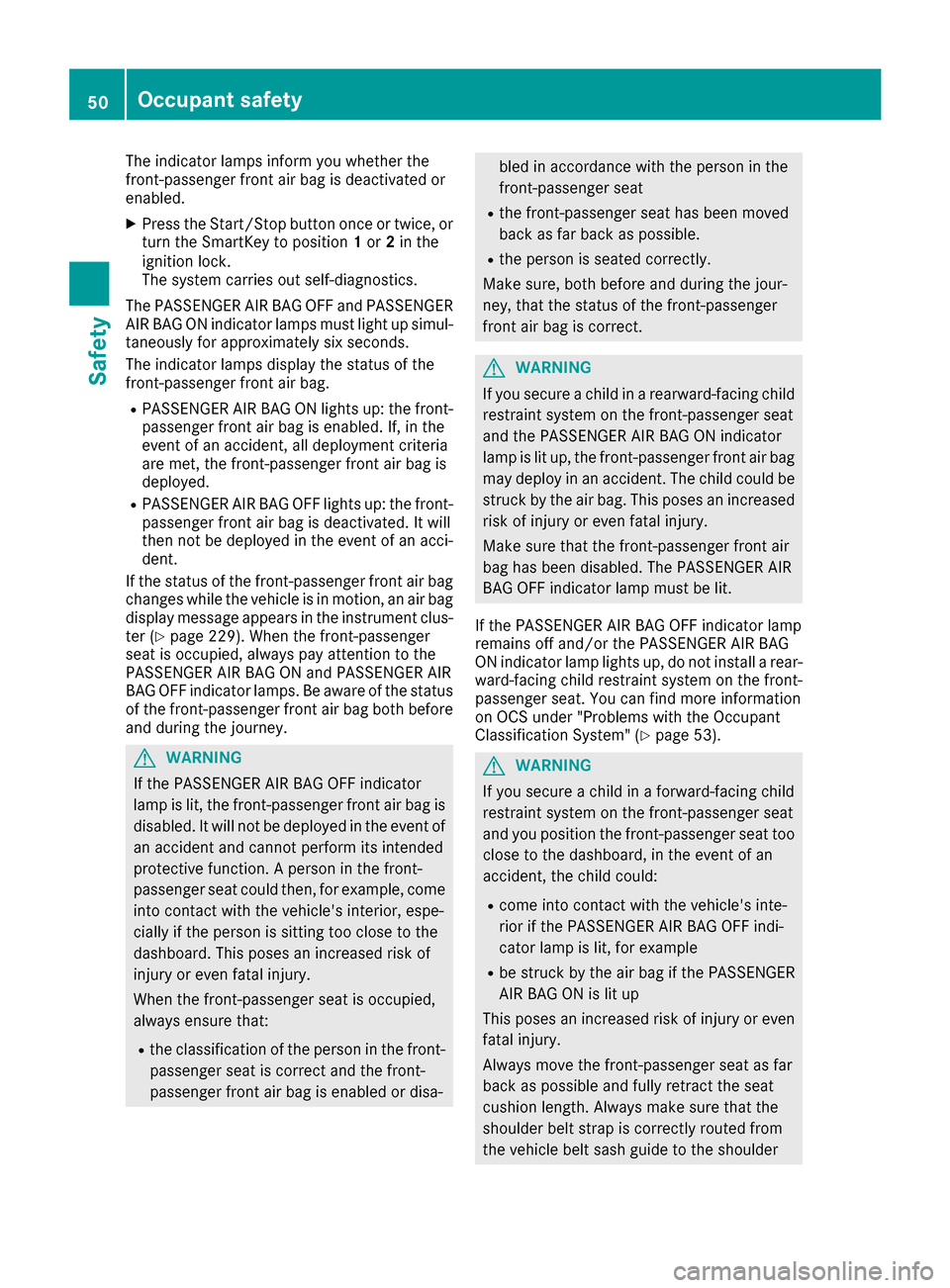
The indicator lamps inform you whether the
front-passenger front air bag is deactivated or
enabled.
XPress the Start/Stop button once or twice, or
turn the SmartKey to position1or 2in the
ignition lock.
The system carries out self-diagnostics.
The PASSENGER AIR BAG OFF and PASSENGER
AIR BAG ON indicator lamps must light up simul-
taneously for approximately six seconds.
The indicator lamps display the status of the
front-passenger front air bag.
RPASSENGER AIR BAG ON lights up: the front-
passenger front air bag is enabled. If, in the
event of an accident ,all deployment criteria
are met, the front-passenger front air bag is
deployed.
RPASSENGER AIR BAG OFF lights up: the front-
passenger front air bag is deactivated. It will
then not be deployed in the event of an acci-
dent.
If the status of the front-passenger front air bag changes while the vehicle is in motion,ana ir bag
display message appears in the instrument clus-
ter (
Ypage 229). When the front-passenger
seat is occupied, alwaysp ay attention to the
PASSENGER AIR BAG ON and PASSENGER AIR
BAG OFF indicator lamps. Be aware of the status
of the front-passenger front air bag both before
and during the journey.
GWARNING
If the PASSENGER AIR BAG OFF indicator
lamp is lit, the front-passenger front air bag is
disabled. It will not be deployed in the event of
an accident and cannot perform its intended
protective function. Aperson in the front-
passenger seat could then ,for example, come
into contact with the vehicle's interior, espe-
cially if the person is sittin gtoo close to the
dashboard. This poses an increased risk of
injury or even fatal injury.
When the front-passenger seat is occupied,
alwayse nsure that:
Rthe classification of the person in the front-
passenger seat is correcta nd the front-
passenger front air bag is enabled or disa-
bled in accordanc ewith the person in the
front-passenger seat
Rthe front-passenger seat has been moved
back as far back as possible.
Rthe person is seated correctly.
Make sure, both before and during the jour-
ney, that the status of the front-passenger
front air bag is correct.
GWARNING
If you secure achild in arearward-facing child
restraint system on the front-passenger seat
and the PASSENGER AIR BAG ON indicator
lamp is lit up, the front-passenger front air bag may deploy in an accident .The child could be
struck by the air bag. This poses an increased
risk of injury or even fatal injury.
Make sure that the front-passenger front air
bag has been disabled. The PASSENGER AIR
BAG OFF indicator lamp must be lit.
If the PASSENGER AIR BAG OFF indicator lamp
remains off and/or the PASSENGER AIR BAG
ON indicator lamp lights up, do not install arear-
ward-facing child restraint system on the front-
passenger seat. You can find more information
on OCS under "Problems with the Occupant
Classification System" (
Ypage 53).
GWARNING
If you secure achild in aforward-facing child
restraint system on the front-passenger seat
and you position the front-passenger seat too close to the dashboard, in the event of an
accident ,the child could:
Rcome into contact with the vehicle's inte-
rior if the PASSENGER AIR BAG OFF indi-
cator lamp is lit, for example
Rbe struck by the air bag if the PASSENGER
AIR BAG ON is lit up
This poses an increased risk of injury or even fatal injury.
Always move the front-passenger seat as far
back as possible and fully retrac tthe seat
cushion length. Always make sure that the
shoulder belt strap is correctly routed from
the vehicle belt sash guide to the shoulder
50Occupant safety
Safety
Page 53 of 354
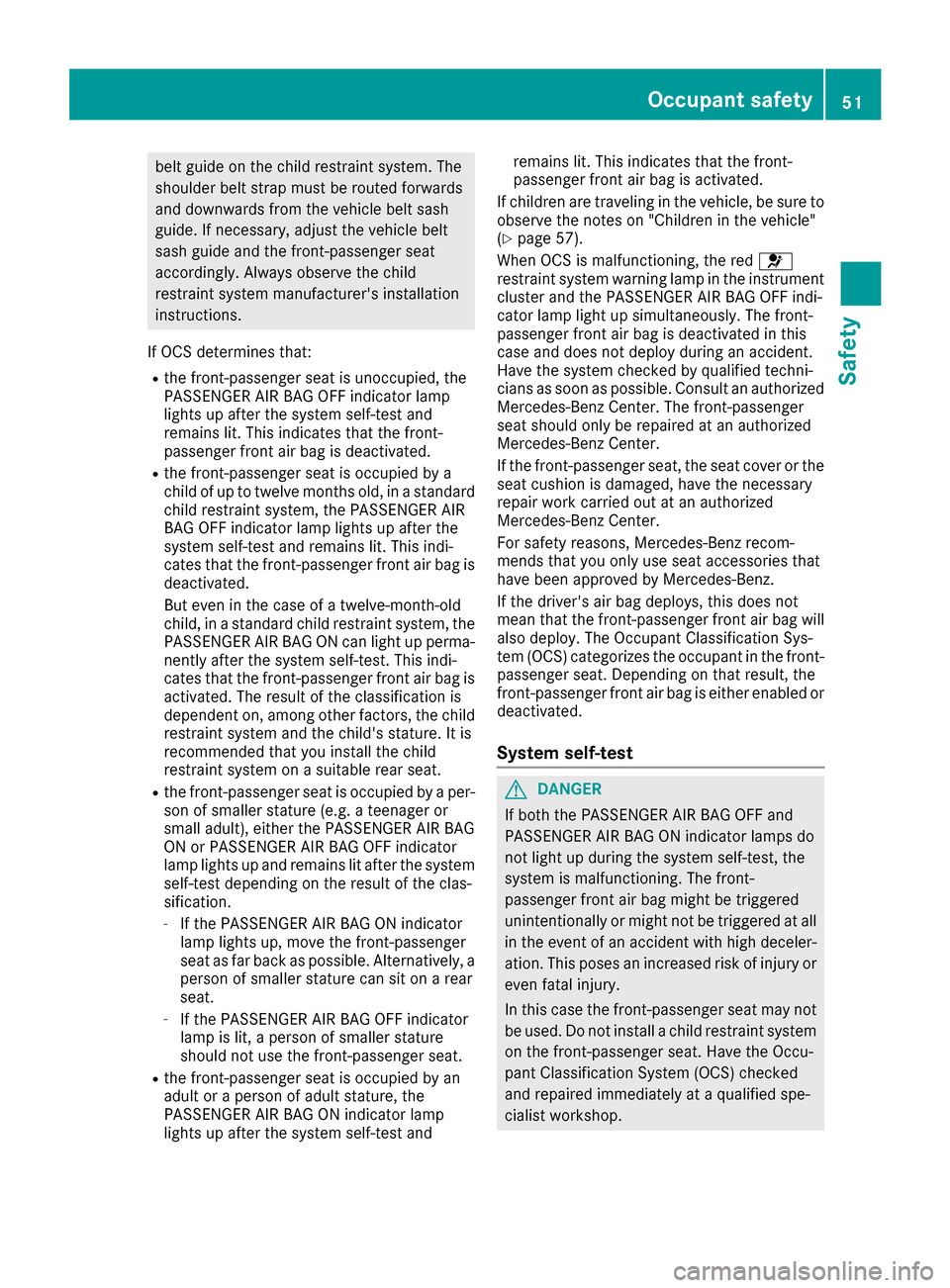
belt guide on the child restraint system. The
shoulder belt strap must be routed forwards
and downwards from the vehicle belt sash
guide. If necessary, adjust the vehicle belt
sash guide and the front-passenger seat
accordingly. Always observe the child
restraint system manufacturer's installation
instructions.
If OCS determines that:
Rthe front-passenger seat is unoccupied, the
PASSENGER AIR BAGO FF indicator lamp
lights up after the system self-test and
remains lit. This indicates that the front-
passenger fronta ir bag is deactivated.
Rthe front-passenger seat is occupied by a
child of up to twelve months old, in astandard
child restraint system, the PASSENGER AIR
BAGO FF indicator lamp lights up after the
system self-test and remains lit. This indi-
cates that the front-passenger fronta ir bag is
deactivated.
But even in the case of atwelve-month-old
child, in astandard child restraint system, the
PASSENGER AIR BAGONc an light up perma-
nently after the system self-test. This indi-
cates that the front-passenger fronta ir bag is
activated. The result of the classification is
dependen ton, among other factors, the child
restraint system and the child's stature. It is
recommended that you install the child
restraint system on asuitable rear seat.
Rthe front-passenger seat is occupied by aper-
son of smaller stature (e.g. ateenager or
small adult), either the PASSENGER AIR BAG
ON or PASSENGER AIR BAGO FF indicator
lamp lights up and remains lit after the system
self-test dependin gonthe result of the clas-
sification.
-If the PASSENGER AIR BAGONi ndicator
lamp lights up, move the front-passenger
seat as far back as possible. Alternatively, a
person of smaller stature can sit on arear
seat.
-If the PASSENGER AIR BAGO FF indicator
lamp is lit, aperson of smaller stature
should not use the front-passenger seat.
Rthe front-passenger seat is occupied by an
adult or aperson of adult stature, the
PASSENGER AIR BAGONi ndicator lamp
lights up after the system self-test and remains lit. This indicates that the front-
passenger fronta
ir bag is activated.
If children are traveling in the vehicle, be sure to
observe the notes on "Children in the vehicle"
(
Ypage 57).
When OCS is malfunctioning, the red 6
restraint system warning lamp in the instrument
cluster and the PASSENGER AIR BAGO FF indi-
cator lamp light up simultaneously. The front-
passenger fronta ir bag is deactivated in this
case and does not deploy during an accident.
Have the system checked by qualified techni-
cians as soon as possible. Consult an authorized
Mercedes-Benz Center .The front-passenger
seat should only be repaired at an authorized
Mercedes-Benz Center.
If the front-passenger seat, the seat cover or the seat cushion is damaged, have the necessary
repair work carried out at an authorized
Mercedes-Benz Center.
For safety reasons ,Mercedes-Benz recom-
mends that you only use seat accessories that
have been approved by Mercedes-Benz.
If the driver'sa ir bag deploys, this does not
mean that the front-passenger fronta ir bag will
also deploy. The Occupant Classification Sys-
tem (OCS) categorizes the occupant in the front-
passenger seat. Depending on that result, the
front-passenger fronta ir bag is either enabled or
deactivated.
System self-test
GDANGER
If both the PASSENGER AIR BAGO FF and
PASSENGER AIR BAGONi ndicator lamps do
not light up during the system self-test, the
system is malfunctioning. The front-
passenger fronta ir bag might be triggered
unintentionally or might not be triggered at all
in the event of an accidentw ith high deceler-
ation. This poses an increased risk of injury or
even fatal injury.
In this case the front-passenger seat may not
be used. Do not install achild restraint system
on the front-passenger seat. Have the Occu-
pant Classification System (OCS) checked
and repaired immediately at aqualified spe-
cialist workshop.
Occupant safety51
Safety
Z
Page 55 of 354

Problems with the Occupant Classification System (OCS)
Be sure to observe the notes on "System self-test"(Ypage 51).
ProblemPossible causes/consequences andMSolutions
The PASSENGER AIR
BAG OFF indicator lamp
lights up and remains lit,
even though the front-
passenger seat is occu-
pied by an adult oraper-
son of astature corre-
sponding to that of an
adult.The classification of the person on the front-passenger seat is incor-
rect.
XMake sure the conditionsf orac orrect classification of the person
on the front-passenger seat are met (Ypage 49).
XIf the PASSENGER AIR BAG OFF indicator lamp remains lit, the front-
passenger seat may not be used.
XHave OCS checked as soon as possible at an authorized Mercedes- Benz Center.
The PASSENGER AIR
BAG OFF indicator lamp
does not light up and/or
does not stay on.
The front-passenger seat
is:
Runoccupied
Roccupied with the
weight of achild up to
twelve months old in a
child restraint system
OCS is malfunctioning.
XMake sure there is nothin gbetween the seat cushion and the child
seat.
XMake sure that the entire base of the child restraint system rests on
the seat cushion of the front-passenger seat. The backrest of the
forward-facing child restraint system must lie as flat as possible
against the backrest of the front-passenger seat. If necessary,
adjust the position of the front-passenger seat.
XMake sure that the seat cushion length is fully retracted.
XWhen installing the child restraint system, make sure that the seat
belt is tight. Do not pull the seat belt tight using the front-passenger seat adjustment .This could result in the seat belt and the child
restraint system being pulled too tightly.
XCheck for correct installation of the child restraint system.
Make sure that the head restraint does not apply aload to the child
restraint system. If necessary, adjust the head restraint accord-
ingly.
XMake sure that no object sare applying additional weight onto the
seat.
XIf the PASSENGER AIR BAG OFF indicator lamp remains off and/or
the PASSENGER AIR BAG ON indicator lamp lights up, do not install ac hild restraint system on the front-passenger seat. It is recom-
mended that you install the child restraint system on asuitable rear
seat.
XHave OCS checked as soon as possible at an authorized Mercedes- Benz Center.
Deployment of Emergency Tensioning
Devices and air bags
Important safety notes
GWARNING
The air bag parts are hot after an air bag has
been deployed. There is arisk of injury.
Do not touch the air bag parts. Have a
deploye dair bag replaced at aqualified spe-
cialist workshop as soon as possible.
GWARNING
Ad eployeda ir bag no longer offers any pro-
tection and cannot provide the intended pro-
Occupant safety53
Safety
Z
Page 56 of 354
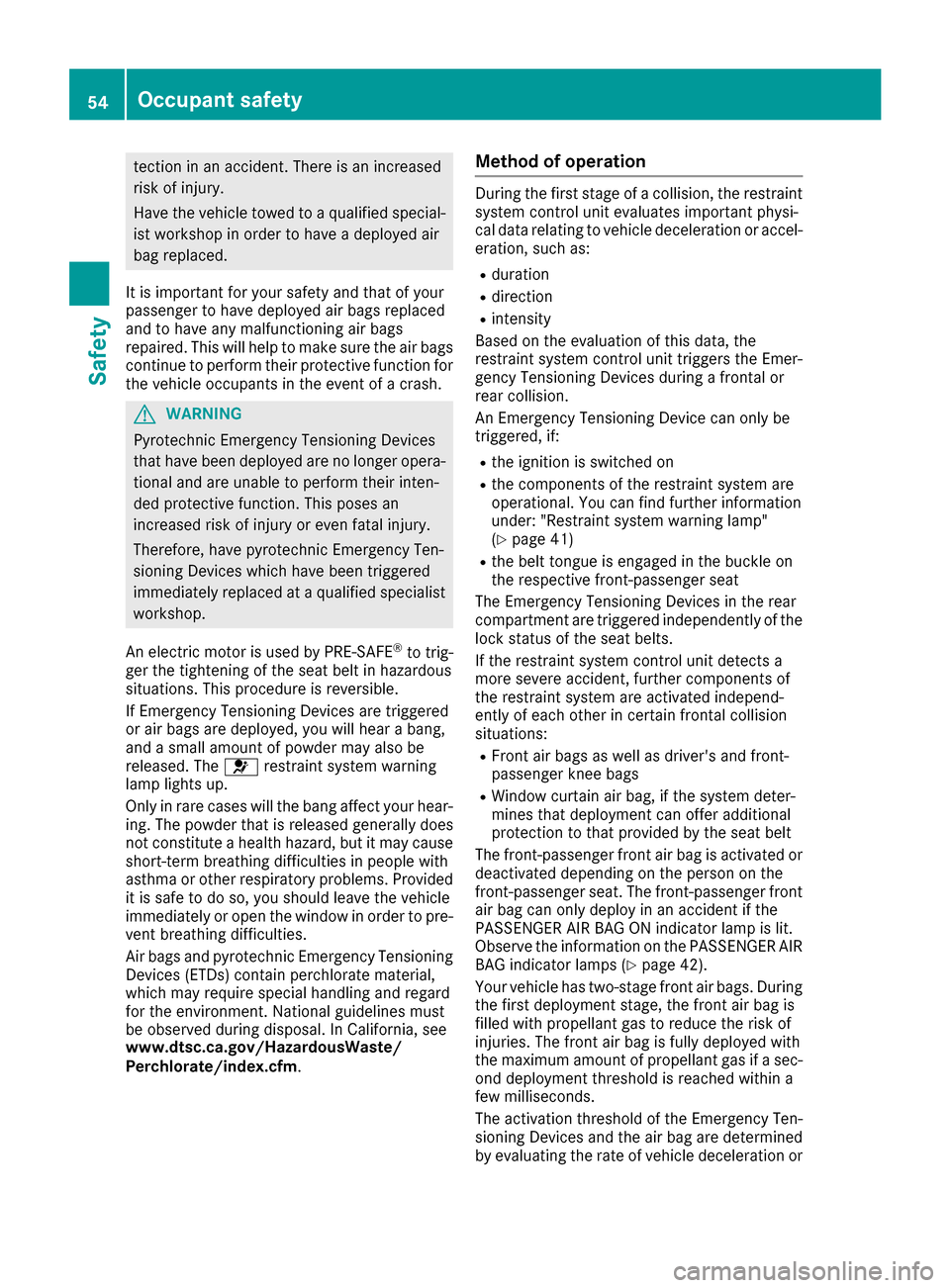
tection in an accident. There is an increased
riskofi njury.
Hav ethe vehicl etowed to aquali fied special-
is tw orkshop in order to have adeployed air
ba gr eplaced.
It is important for your safety and thatofy our
passenge rtohaved eployed airb agsr eplaced
and to have any malfunctioning ai rbags
repaired .Thisw illh elptom akes uret he ai rbags
continue to perform their protective functio nfor
the vehicl eoccupants in the event of acrash.
GWARNING
Pyrotechni cEmergency Tensioning Devices
thath aveb eend eployed arenol ongero pera-
tional and ar eunabl etop erform their inten-
de dp rotective function. Thi sposes an
increasedr iskofi njury or eve nfatal injury.
Therefore ,havep yrotechni cEmergency Ten-
sioning Devices which have been triggered
immediatel yreplaced at aquali fied specialist
workshop.
An electri cmotorisu sedbyP RE-SAFE
®to trig-
ge rthe tightening of the seat belt in hazardous
situations. Thi sprocedur eisreversible.
If Emergency Tensioning Devices ar etriggered
or ai rbagsa redeployed ,you will hear abang,
and asmall amount of powder maya lsob e
released. The 6restraint systemw arning
lamp lights up.
Onlyinr arec ases will the bang affect your hear-
ing .The powder thati sreleasedg enerall ydoes
not constitute ahealth hazard, bu titmaycause
short-ter mbreathing difficultie sinpeoplewith
asthma or othe rrespiratory problems .Provided
it is safe to do so, yo ushoul dleave the vehicle
immediatel yoropent he windo winorder to pre-
vent breathing difficulties.
Air bags and pyrotechni cEmergency Tensioning
Devi ces (
ETDs) contain perchlorate material,
which mayr equire special handling and regard
for the environment. National guideline smust
be observe dduringd ispo sal. In California ,see
www.dtsc.ca.gov/HazardousWaste/
Perchlorate/index.cfm.
Methodofo peration
During the first stage of acollision, the restraint
systemc ontrolunite valuate simportant physi-
cal data relating to vehicl edeceleratio noraccel-
eration, such as:
Rduration
Rdirection
Rintensity
Based on the evaluation of thisd ata, the
restraint systemc ontrol unittriggers the Emer-
gency Tensioning Devices durin gafrontal or
rea rcollision.
An Emergency Tensioning Device can onl ybe
triggered ,if:
Rthe ignition is switched on
Rthe components of the restraint systema re
operational .You can fin dfurthe rinformation
under: "Restraint systemw arning lamp"
(
Ypage 41)
Rthe belt tongue is engaged in the buckle on
the respectiv efront-passenge rseat
The Emergency Tensioning Devices in the rear
compartment ar etriggered independentl yofthe
lock status of the seat belts.
If the restraint systemc ontrol unitdetects a
mor eseverea ccident, furthe rcomponents of
the restraint systema reactivated independ-
entl yofe acho the rinc ertainfrontal collision
situations:
RFron tairbags as well as driver's and front-
passenge rknee bags
RWindo wcurtai nairbag, if the systemd eter-
mines thatd eployment can offer additional
protection to thatp rovided bythe s
eat belt
The front-passenge rfront ai rbag is activated or
deactivated depending on the perso nonthe
front-passenge rseat. The front-passenge rfront
ai rb ag can onl ydeplo yinana ccident if the
PASSENGER AIR BAG ON indicator lamp is lit.
Observe the information on the PASSENGER AIR
BAG indicator lamps (
Ypage 42).
Your vehicl ehastwo-stage front ai rbags. During
the first deployment stage ,the front ai rbag is
fille dwithp ropellant ga storeduce the ris kof
injuries. Th efront ai rbag is full ydeployed with
the maximum amount of propellant ga sifasec-
ond deployment threshold is reache dwithina
few milliseconds.
The activatio nthreshold of the Emergency Ten-
sioning Devices and the ai rbag ared etermined
by evaluating the rate of vehicl edeceleratio nor
54Occupant safety
Safety
Page 58 of 354
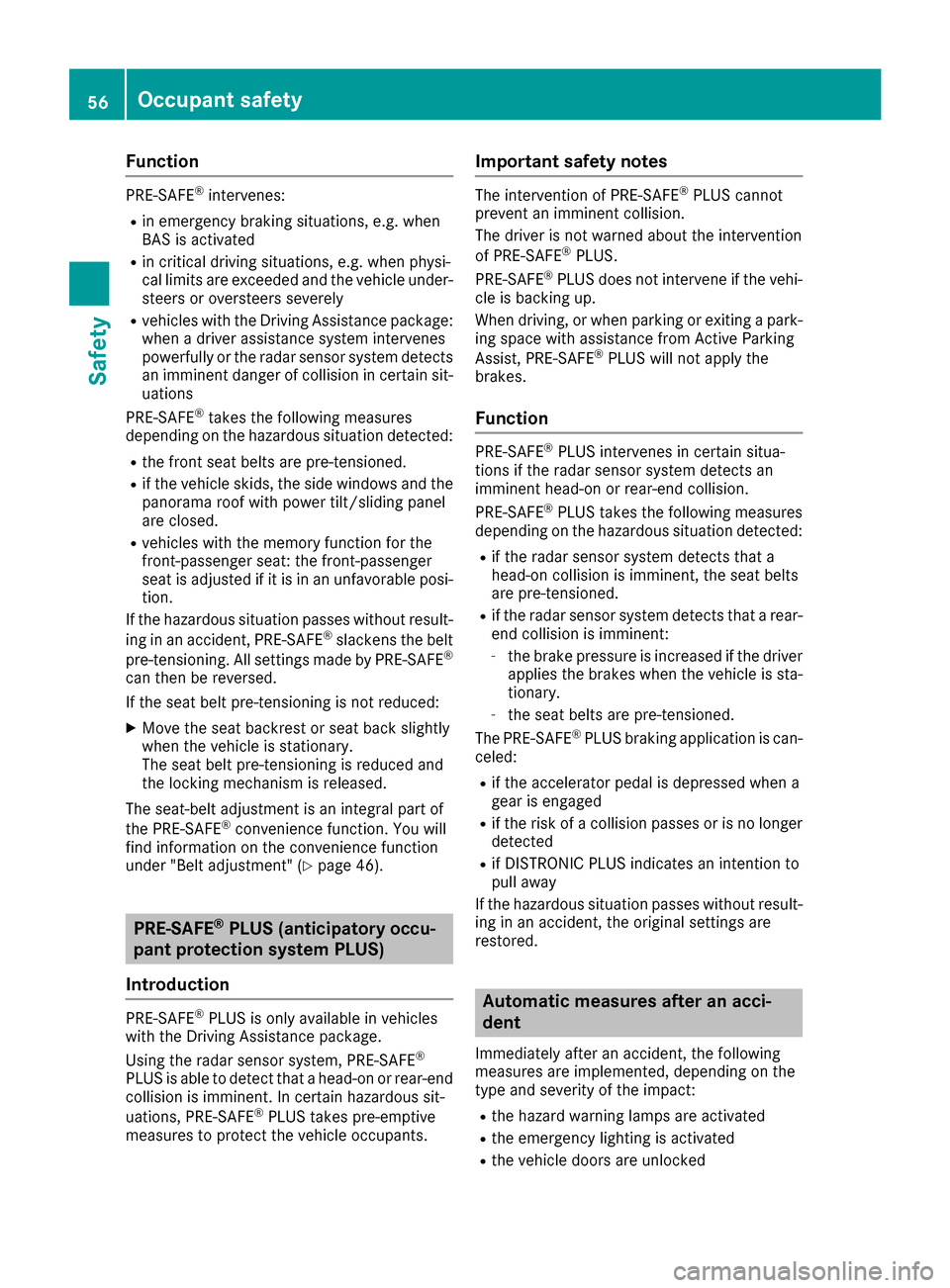
Function
PRE-SAFE®intervenes:
Rin emergenc ybraking situations, e.g. when
BA Sisa ctivated
Rin critical driving situations, e.g. when physi-
cal limits are exceeded and th evehicl eunder-
steer soro versteer sseverely
Rvehicles wit hthe Drivin gAssistanc epackage:
when adriver assistanc esystem intervenes
powerfully or th eradar sensor system detect s
an imminent danger of collision in certai nsit-
uation s
PRE-SAF E
®takes thefollowin gmeasures
depending on th ehazardous situation detected:
Rthef ront seat belt sare pre-tensioned.
Rif th evehicl eskids, th eside windows and th e
panoram aroofw ithp ower tilt/slidin gpanel
are closed.
Rvehicles wit hthe memory function for th e
front-passenger seat :the front-passenger
seat is adjusted if it is in an unfavorable posi -
tion .
If th ehazardous situation passes without result -
ing in an accident, PRE-SAF E
®slackens thebelt
pre-tensioning .All setting smade by PRE-SAF E®
can then be reversed.
If theseat belt pre-tensioning is no treduced:
XMov ethe seat backrest or seat bac kslightly
when th evehicl eiss tationary.
The seat belt pre-tensioning is reduce dand
th el ockin gmechanism is released.
The seat-belt adjustmen tisanintegral part of
th eP R
E-SAF E®convenience function .You will
fin dinformation on th econveni ence function
under "Belt adjustment" (
Ypage 46).
PRE-SAFE®PLUS (anticipatory occu-
pant protection system PLUS)
Introduction
PRE-SAF E®PLUSiso nlya vailable in vehicles
wit hthe Drivin gAssistanc epackage.
Usin gthe radar sensor system, PRE-SAF E
®
PLUSisa ble to detect that ahead-on or rear-end
collision is imminent .Incertainhazardous sit -
uations, PRE-SAF E
®PLUStakes pre-emptive
measures to protect th evehicl eoccupants.
Important safety notes
The intervention of PRE-SAF E®PLUScanno t
preven tanimminent collision .
The driver is no twarned about th eintervention
of PRE-SAF E
®PLUS.
PRE-SAF E®PLUSdoes no tinterven eifthevehi-
cle is backin gup.
When driving ,orwhen parking or exiting apark -
ing spac ewitha ssistanc efromA ctiveParking
Assist ,PRE-SAF E
®PLUSwill no tapply th e
brakes.
Function
PRE-SAF E®PLUSintervenes in certai nsitua-
tion sift heradar sensor system detect san
imminent head-on or rear-end collision .
PRE-SAF E
®PLUStakes th efollowin gmeasures
depending on th ehazardous situation detected:
Rif th eradar sensor system detect sthata
head-on collision is imminent ,the seat belt s
are pre-tensioned.
Rif th eradar sensor system detect stha tar ear-
en dc ollision is imminent :
-theb rak epressur eisincreased if th edriver
applie sthe brakes when th evehicl eiss ta-
tionary.
-th es eat belt sare pre-tensioned.
The PRE-SAF E®PLUSbraking application is can -
celed:
Rif th eaccelerato rpedal is depressed when a
gear is engage d
Rif theriskofac ollision passes or is no longer
detected
Rif DISTRONI CPLUSindicates an intention to
pull away
If th ehazardous situation passes without result -
ing in an accident, th eoriginal setting sare
restored .
Automati cmeasures after an acci-
dent
Immediately after an accident, th efollowin g
measures are implemented, depending on th e
typ eand severit yoftheimpact :
Rtheh azard warning lamps are activated
Rthee mergenc ylighting is activated
Rthev ehicl edoor sare unlocked
56Occupant safety
Safety
Page 59 of 354
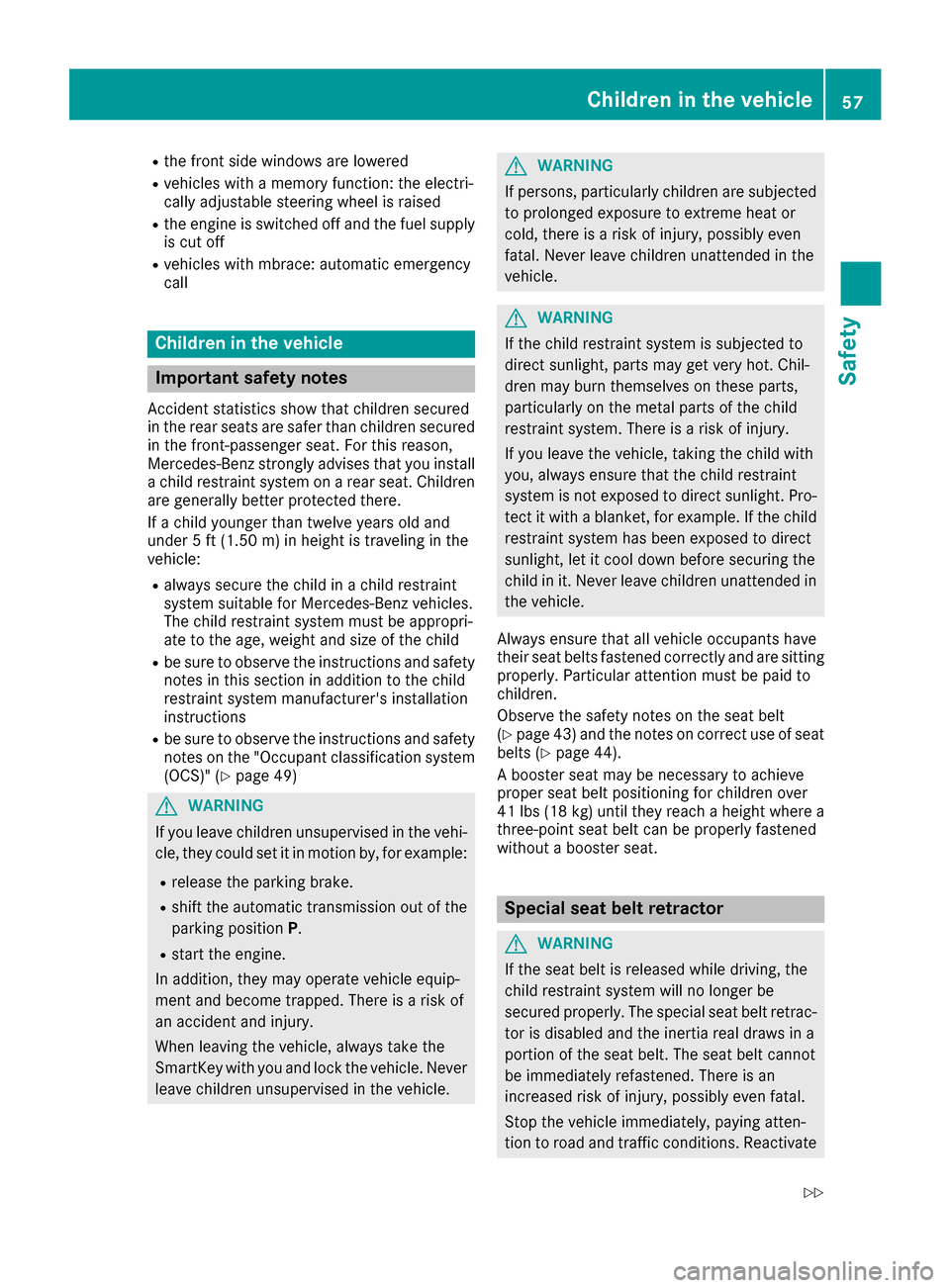
Rthe front side windows arelower ed
Rvehicles with amemory function: the electri-
cally adjustable steering whee lisraised
Rthe engine is switched off and the fuel supply
is cut off
Rvehicles with mbrace :automatic emergency
call
Children in the vehicle
Important safety notes
Accident statistics sho wthatc hildren secured
in the rea rsea ts ar esafer thanc hildren secured
in the front-passenge rseat. For thisr eason,
Mercedes-Benz strongl yadvises thaty ouinstall
ac hild restraint systemonar ears eat. Children
ar eg enerall ybetter protecte dthere.
If ac hild younger thant welve yearsoldand
under 5ft(1.50 m)in height is travelingint he
vehicle:
Ralways secur ethe child in achild restraint
system suitable for Mercedes-Ben zvehicles.
The child restraint system must be appropri-
ate to the age, weight and size of the child
Rbe sure to observe the instructions and safety
notes in this section in addition to the child
restraint system manufacturer'si nstallation
instructions
Rbe sure to observe the instructions and safety
notes on the "Occupant classification system
(OCS)" (
Ypage 49)
GWARNING
If you leave children unsupervised in the vehi-
cle, the ycould set it in motion by, for example:
Rrelease the parking brake.
Rshift the automatic transmission out of the
parking position P.
Rstartthe engine.
In addition ,the ym ay operatev ehicle equip-
menta nd becom etrapped. There is arisk of
an accident and injury.
When leavingt he vehicle, always tak ethe
SmartKey with you and lock the vehicle. Never
leave children unsupervised in the vehicle.
GWARNING
If persons, particularly children are subjected to prolonged exposure to extreme heat or
cold, there is arisk of injury, possibly even
fatal. Never leave children unattended in the
vehicle.
GWARNING
If the child restraint system is subjected to
directs unlight, partsm ay get very hot.C hil-
dren may burn themselves on these parts,
particularly on the metal partsoft he child
restraint system. There is arisk of injury.
If you leave the vehicle, taking the child with
you, always ensure that the child restraint
system is not exposed to directs unlight. Pro-
tec titw ithablanket, for example. If the child
restraint system has been exposed to direct
sunlight, let it cool down befores ecuring the
child in it. Never leave children unattended in
the vehicle.
Always ensure that all vehicle occupant shave
their seat belts fastened correctly and are sitting
properly. Particular attention must be paid to
children.
Observe the safetyn otes on the seat belt
(
Ypage 43) and the notes on correctu se of seat
belts (Ypage 44).
Ab ooster seat may be necessary to achieve
proper seat belt positionin gfor children over
41 lbs (1 8kg)until the yreach aheight where a
three-point seat belt can be properly fastened
without abooster seat.
Specia lseat belt retractor
GWARNING
If the seat belt is released while driving, the
child restraint system will no longer be
secured properly. The special seat belt retrac- tor is disabled and the inertia real draws in a
portion of the seat belt. The seat belt cannot
be immediately refastened. There is an
increased risk of injury, possibly even fatal.
Stop the vehicle immediately, paying atten-
tion to road and traffic conditions. Reactivate
Children in th evehicle57
Safety
Z
Page 64 of 354
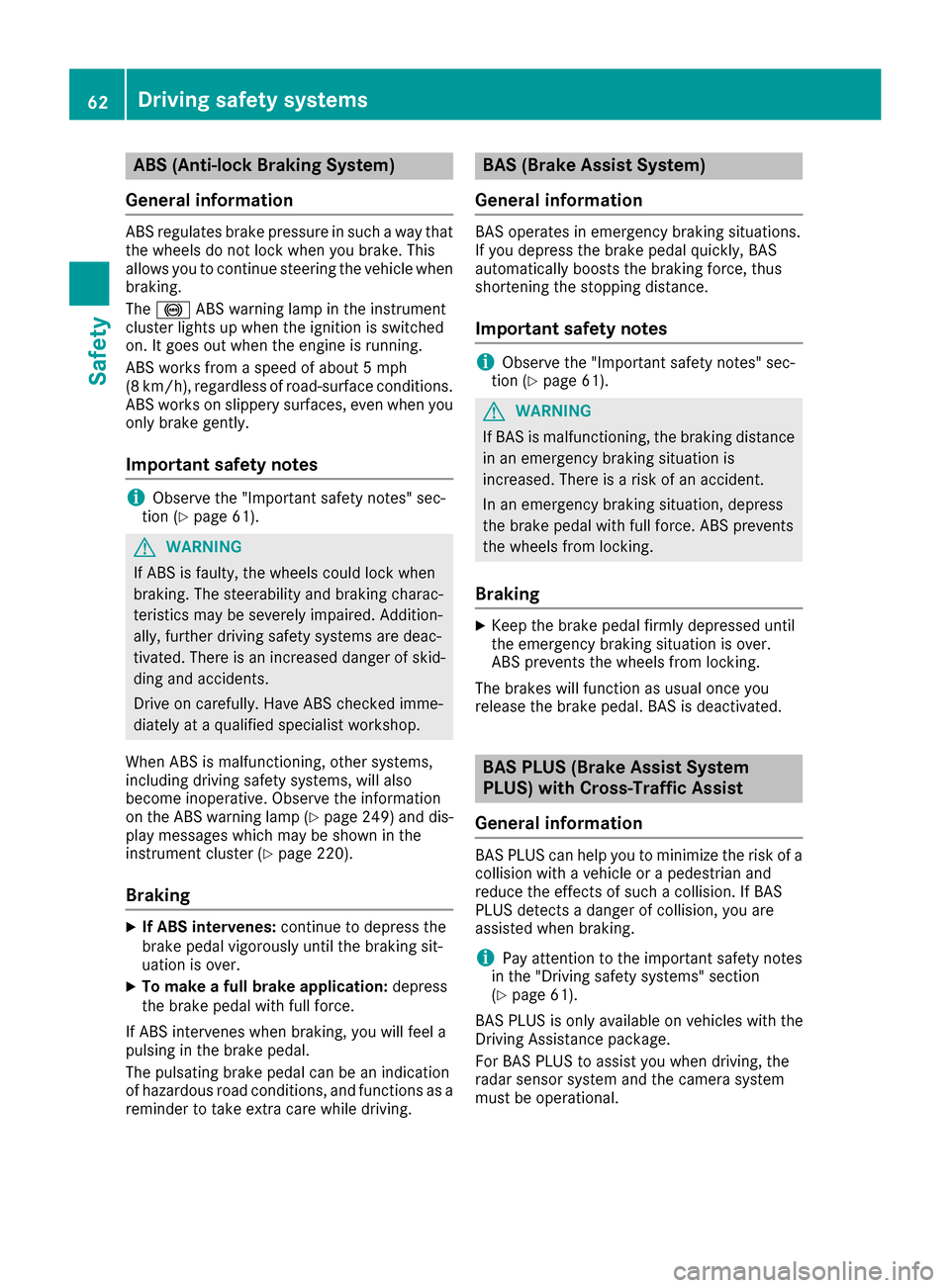
ABS (Anti-lock Braking System)
Gene ralinform ation
ABSregulates brak epressur einsuchaw ay that
th ew heels do no tloc kw hen you brake. This
allows you to continu esteering th evehicl ewhen
braking .
The ! ABSw arning lamp in th einstrumen t
cluste rlights up when th eignition is switched
on .Itg oeso ut when th eengineisr unning.
AB Sw orks from aspee dofa bout5mph
(8 km/h), regardless of road-surface conditions.
AB Sw orks on slipper ysurfaces, eve nwhen you
only brak egently.
Import ant safety notes
iObservethe "Importan tsafet ynotes "sec-
tion (Ypage 61).
GWARNIN G
If AB Sisf aulty, th ewheels could loc kwhen
braking .The steerabilit yand braking charac -
teristics may be severely impaired. Addition -
ally, further drivin gsafet ysystems are deac -
tivated. There is an increased danger of skid-
din gand accidents .
Drive on carefully. Hav eABS checke dimme-
diately at aqualified specialis tworkshop .
When AB Sismalfunctioning ,other systems ,
includin gdrivin gsafet ysystems ,will also
become inoperative. Observ ethe information
on th eABS warning lamp (
Ypage 249) and dis-
play message swhichm ay be shown in th e
instrumen tcluste r(
Ypage 220).
Braking
XIf ABS intervenes: continuetodepress th e
brak epedal vigorously until th ebraking sit -
uation is over.
XTo make afullb rake application: depress
th eb rak epedal wit hfull force .
If AB Sintervenes when braking ,you will fee la
pulsing in th ebrak epedal .
The pulsating brak epedal can be an indication
of hazardous road conditions, and function sasa
reminder to tak eextra carew hile driving.
BAS (Brak eAssistS ystem)
Gene ralinform ation
BASo perate sinemergenc ybraking situations.
If you depress th ebrak epedal quickly, BA S
automatically boosts th ebraking force ,thu s
shortening th estopping distance.
Imp ortant safety notes
iObserv ethe "Importan tsafet ynotes "sec-
tion (Ypage 61) .
GWARNIN G
If BA Sism alfunctioning ,the braking distanc e
in an emergenc ybraking situation is
increased. There is ariskofana ccident.
In an emergenc ybraking situation ,depress
th eb rak epedal wit hfull force .ABS prevents
th ew heels from locking .
Braking
XKeepthe brak epedal firmly depressed until
th ee mergenc ybraking situation is over.
AB Sp revents th ewheels from locking .
The brakes will function as usual once you
release th ebrak epedal .BAS is deactivated.
BAS PLUS (Brak eAssistS ystem
PLUS)w ith Cross-Traffic Assist
Gene ralinform ation
BASP LUSc an help you to minimiz ethe riskofa
collision wit havehicleorap edestrian and
reduce th eeffects of suc hacollision .IfBAS
PLU Sdetects adanger of collision ,you are
assisted when braking .
iPay attention to theimportant safet ynotes
in th e"Drivin gsafet ysystems "section
(
Ypage 61) .
BA SP LUSiso nlya vailable on vehicles wit hthe
Drivin gAssistance package.
Fo rB AS PLU Stoa ssist you when driving, th e
radar sensor system and th ecamera system
mus tbeo perational.
62Driving safety systems
Safety
Page 69 of 354

ESP®(Electronic Stability Program)
General notes
iObserv ethe "Important safety notes" sec-
tio n(Ypage 61).
ESP
®monitors driving stabilitya nd traction,i.e.
power transmission between th etires and the
road surface.
If ESP
®detect stha tthe vehicle is deviatin gfrom
th ed irection desired by th edriver, oneorm ore
wheels are braked to stabilizet hevehicle .The
engine output is also modified to keep th evehi-
cle on th edesired course within physical limits.
ESP
®assists th edriver when pullinga way on
wet or slippery roads. ESP®can also stabilize
th ev ehicle durin gbraking.
Important safety notes
iObserv ethe "Important safety notes" sec-
tio n(Ypage 61).
GWARNING
If ESP
®is malfunctioning, ESP®is unabl eto
stabilizet hevehicle .Additionally, further driv-
ing safety systems are deactivated. This
increases th erisk of skiddinga nd an accident.
Drive on carefully. Hav eESP
®checked at a
qualified specialist workshop.
When towing th evehicle with th erear axle
raised, observ ethe note sonE SP
®
(Ypage 311).
If the å ESP®OFFw arning lamp lightsu p
continuously, ESP®is deactivated.
If the ÷ ESP®warning lamp lightsupc ontin-
uously, ESP®is no tavailabl edue to amalfunc-
tion.
Observ ethe informatio nonwarning lamps
(
Ypage 249) and display messages whichm ay
be shown in th einstrumen tcluster
(
Ypage 220).
Only use wheels with th erecommended tire
sizes. Only then will ESP
®function properly.
Characteristics of ESP®
General information
If the ÷ ESP®warning lamp goes out before
beginnin gthe journey, ESP®is automatically
active.
If ESP
®intervenes, the ÷ESP®warning lamp
flashes in th einstrumen tcluster.
If ESP
®intervenes:
XDo no tdeactivate ESP®unde rany circum-
stances.
XOnly depress th eaccelerato rpedal as far as
necessaryw hen pullinga way.
XAdaptyour driving style to suit th eprevailing
road and weather conditions.
ECO start/stop function
The ECO start/sto pfunction switches the
engine off automaticall ywhen th evehicle stops
moving .The engine start sautomaticall ywhen
th ed river want stopull away again.E SP
®
remains in its previously selecte dstatus. Exam-
ple: if ESP®was deactivate dbefore th eengine
was switched off ,ESP®remains deactivated
when th eengine is switched on again.
Deactivating/activatin gESP®(except
Mercedes ‑AM Gvehicles)
Important safety notes
iObserv ethe "Important safety notes" sec-
tio n(Ypage 61).
You can selectb etween thefollowings tate so f
ESP
®:
RESP®is activated.
RESP®is deactivated.
GWARNING
If you deactivate ESP
®,E SP®no longer sta-
bilizes th evehicle .Thereisani ncreased risk
of skiddinga nd an accident.
Only deactivate ESP
®in th esituations descri-
bed in th efollowing.
Driving safety systems67
Safety
Z
Page 70 of 354

It may be best to deactivate ESP®in the follow-
ing situations:
Rwhen using snow chains
Rin deep snow
Ron sand or gravel
iActivate ESP®as soon as the situations
describeda bove no longer apply. ESP®will
otherwise not be abl etostabilize the vehicle if
the vehicle starts to skid or awheel starts to
spin.
!Avoid spinning the driven wheel sfor an
extended period with ESP®deactivated. You
could otherwise damage the drivetrain.
Deactivating/activating ESP®
You can deactivate or activate ESP®via the on-
board computer (Ypage 212)
ESP®deactivated:
The å ESP®OFF warning lamp in the instru-
ment cluster lights up.
ESP
®activated:
The å ESP®OFF warning lamp in the instru-
ment cluster goes out.
Characteristic swhen ESP®is deactivated
If ESP®is deactivated and one or more wheels
start to spin, the ÷ESP®warning lamp in the
instrument cluster flashes. In such situations,
ESP
®wil lnot stabilize the vehicle.
If you deactivate ESP®:
RESP®no longer improves driving stability.
REngine torque is no longer limited and the
drive wheel sare abl etospin.
The spinning of the wheel sresults in acutting
action for better traction on loose surfaces.
RTraction control is still activated.
RCOLLISION PREVENTION ASSISTisnol onger
available; nor is it activated if you brake firmly
with assistance from ESP
®.
RPRE-SAFE®is no longer available, nor is it
activated if you brake firmly and ESP®inter-
venes.
RPRE-SAFE®Brake is no longer available, it is
also not activated if you brake firmly and ESP®
intervenes.
RESP®still providess upport when you brake
firmly.
Deactivating/activating ESP®
(Mercedes‑AMG vehicles)
Important safety notes
iObserve the "Important safety notes" sec-
tion (Ypage 61).
You can select betwee nthe following states of
ESP
®:
RESP®is activated.
RSPORT handling mode is activated.
RESP®is deactivated.
GWARNING
When SPORT handling mode is activated,
there is agreater risk of skidding and acci-
dents.
Only activate SPORT handling mode in the sit-
uations describedint he following.
GWARNING
If you deactivate ESP
®,E SP®no longer sta-
bilizes the vehicle.T here is an increased risk
of skidding and an accident.
Only deactivate ESP
®in the situations descri-
bed in the following.
!Avoid spinning the driven wheelsf or an
extended period with ESP®deactivated. You
could otherwise damage the drivetrain.
In the following situations, it may be better to
activate SPORT handling mode or deactivate
ESP
®:
Rwhen using snow chains
Rin deep snow
Ron sand or gravel
Ron specially designated roads when the vehi-
cle's own oversteering and understeering
characteristics are desired
Driving in SPORT handling mode or without
ESP
®requires an extremely qualifieda nd expe-
rienced driver.
iActivate ESP®as soon as the situations
describeda bove no longer apply. ESP®will
otherwise not be abl etostabilize the vehicle if
the vehicle starts to skid or awheel starts to
spin.
68Driving safety systems
Safety
Page 79 of 354

SmartKey battery
Important safety notes
GWARNING
Batteries contain toxic and corrosive substan- ces. If batteries are swallowed, it can result in
severe health problems. There is arisk of fatal
injury.
Keep batteries out of the reach of children. If
ab attery is swallowed, seek medical attention
immediately.
HEnvironmental note
Batteries contain dangerous
substances. It is against the
law to dispose of them with
the household rubbish. They
must be collected separately and recycled to protect the
environment.
Dispose of batteries in an
environmentally friendly
manner. Take discharged
batteries to aqualified spe-
cialist workshop or aspecial
collection point for used bat-
teries.
The SmartKey batteries contain perchlorate
material, which may require special handling
and regard for the environment. National guide-
lines must be observed during disposal. In Cal-
ifornia, see www.dtsc.ca.gov/
HazardousWaste/Perchlorate/index.cfm .
Mercedes-Benz recommends that you have the
batteries replaced at aqualified specialist work-
shop.
Checking the battery
XPress the &or% button.
The battery is working properly if battery
check lamp :lights up briefly.
The battery is discharged if battery check
lamp :does not light up briefly.
XChange the battery (Ypage 77).
If the SmartKey battery is checked within the
signal reception range of the vehicle, pressing
the & or% button:
Rlocks or
Runlocks the vehicle
iYou can get abattery at any qualified spe-
cialist workshop.
Replacing the battery
You require aCR20253Vc ell battery.
XTake the mechanical key out of the SmartKey
(Ypage 76).
XPress mechanical key ;into the SmartKey
opening in the direction of the arrow until bat-
tery compartmentc over:opens. Do not
hold battery compartmentc over:closed
while doing so.
XRemove battery compartmentc over:.
SmartKey77
Opening and closing
Z